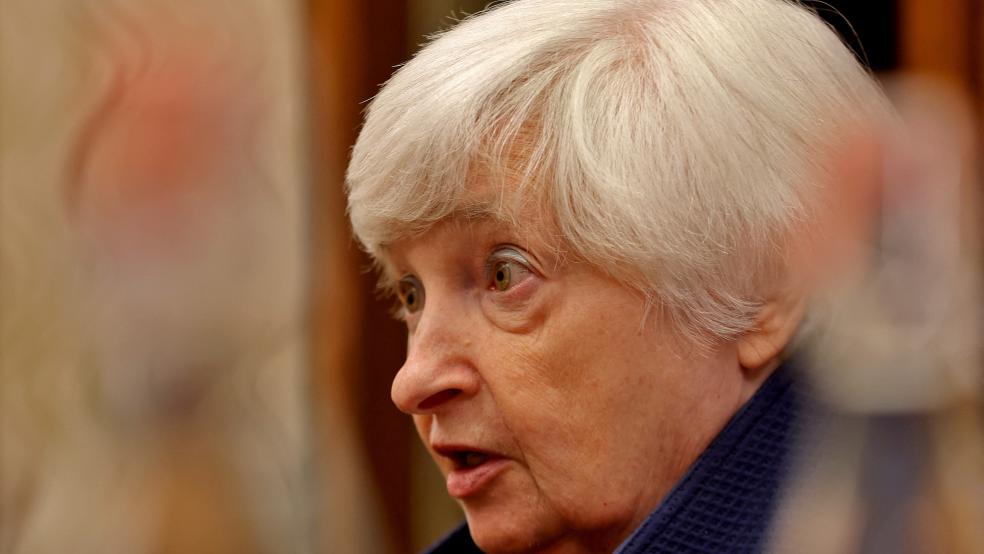The United States officially hit its congressionally authorized borrowing limit of $31.381 trillion on Thursday, forcing the Treasury Department to start using “extraordinary measures” to avoid a market-shaking default on its debt.
Treasury Secretary Janet Yellen had warned last week that the debt limit would be reached today. In a letter to congressional leaders Thursday she said the government would suspend debt issuance through June 5 and hold off on making certain investments in federal retirement funds, part of a series of technical maneuvers meant to buy time for lawmakers to address the borrowing limit.
“As I stated in my January 13 letter, the period of time that extraordinary measures may last is subject to considerable uncertainty, including the challenges of forecasting the payments and receipts of the U.S. Government months into the future,” Yellen wrote. “I respectfully urge Congress to act promptly to protect the full faith and credit of the United States.”
A default could unleash economic chaos, disrupting global financial markets and damaging the U.S. economy if, for example, the government can’t pay Social Security benefits and military salaries.
We’ve been here before: “The United States has never defaulted on its debt,” writes Jacob Bogage of The Washington Post. “But it has repeatedly come close, particularly in 2011, amid the rise of the conservative tea party movement in the House. Those Republicans’ clashes with then-president Barack Obama resulted in months of political brinkmanship, generated panic globally and yielded a decade of significant caps on domestic spending, which Democrats have long decried as damaging.”
Why this time might be different: Conservative Republicans, emboldened by their sway given the GOP’s narrow majority in the House, may be itching to exert their influence and force Democrats to swallow steep spending cuts. Some have even flirted with the notion of not raising the debt limit. House Republicans may be prepared to take their brinkmanship further than ever before, and Speaker Kevin McCarthy faces a difficult balancing act since any House member can call for a vote to oust him under the rules agreement he struck earlier this month.
The White House, meanwhile, insists it will not negotiate over the debt ceiling and that Congress should raise the limit without strings attached, as it has done many times before. That refusal to engage reflects lessons Democrats took away from 2011 and other past standoffs, fearing that any concessions will only result in Republicans again looking to extract a ransom for doing what’s necessary.
Administration officials also argue that Republicans don’t really care about shrinking the budget deficit, pointing as evidence to the first piece of legislation passed by the new House Republican majority — a bill to cut funding provided by Democrats for the IRS. A Congressional Budget Office analysis found that the GOP bill would raise deficits by $114 billion over a decade.
Congressional Democrats and some Republicans are also eager to avoid any potential default. Senate Minority Leader Mitch McConnell (R-KY) said Thursday that he “would not be concerned about a financial crisis” ahead, predicting that the White House will eventually engage. “I think the important thing to remember is that America must never default on its debt. It never has, and it never will,” he said. “We’ll end up in some kind of negotiation with the administration over what the circumstances or conditions under which the debt ceiling be raised.”
What do House Republicans want? McCarthy hasn’t publicly laid out specific demands. Among the concessions House conservatives reportedly won in exchange for allowing McCarthy to become speaker were a commitment to not bring a “clean” debt limit increase up for a vote and an agreement to set spending for the next fiscal year at 2022 levels, requiring cuts of about $130 billion. Some in the party have floated changes to Social Security and Medicare. Republicans have also shown some internal divisions about whether their proposed cuts would include defense spending or not.
“The American people rightfully recognize that maintaining Washington’s status quo, which runs up massive deficits and adds trillions to our national debt, is unsustainable,” House Ways and Means Committee Chairman Jason Smith (R-MO) said in a statement, noting that federal revenues reached a record high of $4.9 trillion last year. “Instead of attacking his political opponents, President Biden should be spending this time working with House Republicans to address the debt ceiling in a way that imposes some fiscal sanity.”
House Republicans are also pushing to balance the federal budget in 10 years — and to do so by only cutting spending, not raising revenue, a feat that Howard Gleckman, a senior fellow at the Urban-Brookings Tax Policy Center, says is simply impossible. Similarly, the Committee for a Responsible Federal Budget said in an analysis published this month that, to achieve balance within a decade, “all spending would need to be cut by roughly one-quarter and that the necessary cuts would grow to 85 percent if defense, veterans, Social Security, and Medicare spending were off the table.”
Rep. Rosa DeLauro of Connecticut, the top Democrat on the House Appropriations Committee, sent letters Thursday to the heads of federal agencies asking them to report how their services would be affected if spending levels were capped at fiscal 2022 levels. “A preliminary examination of this blueprint suggests this proposed policy would harm communities across the country and our national security interests around the world,” she wrote.
The bottom line: We’re watching yet another high-stakes game of chicken, and the players are nowhere near swerving yet.





